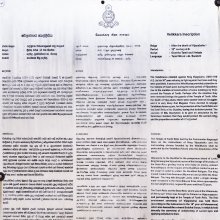Ve, Vé: 11 definitions
Introduction:
Ve means something in Hinduism, Sanskrit, Buddhism, Pali, Jainism, Prakrit, Hindi, biology, Tamil. If you want to know the exact meaning, history, etymology or English translation of this term then check out the descriptions on this page. Add your comment or reference to a book if you want to contribute to this summary article.
Images (photo gallery)
(+14 more images available)
Biology (plants and animals)
Source: Google Books: CRC World Dictionary (Regional names)Ve in Senegal is the name of a plant defined with Abutilon pannosum in various botanical sources. This page contains potential references in Ayurveda, modern medicine, and other folk traditions or local practices It has the synonym Sida mutica Del. ex DC. (among others).
Example references for further research on medicinal uses or toxicity (see latin names for full list):
· Pakistan Journal of Scientific and Industrial Research (1989)
· Fragmenta florulae aethiopico-aegyptiacae (1854)
· Journal of Vegetation Science (1996)
· Commentarii Societatis Regiae Scientiarum Gottingensis (1789)
· Pakistan Journal of Botany (1988)
· Botanische Zeitung Berlin (1851)
If you are looking for specific details regarding Ve, for example diet and recipes, extract dosage, chemical composition, pregnancy safety, side effects, health benefits, have a look at these references.

This sections includes definitions from the five kingdoms of living things: Animals, Plants, Fungi, Protists and Monera. It will include both the official binomial nomenclature (scientific names usually in Latin) as well as regional spellings and variants.
Languages of India and abroad
Pali-English dictionary
Source: Sutta: The Pali Text Society's Pali-English DictionaryVe°, is the guṇa (increment) form of vi°, found in many secondary (mostly f. & nt. abstr.) derivations from words with vi°, e.g. vekalla, vecikicchin, veneyya, vepulla, vematta, vevicchā, veramaṇī, which Bdhgh explains simply as “vi-kārassa ve-kāraṃ katvā veramaṇī” KhA 24. ‹-› Cp. veyy°. (Page 646)

Pali is the language of the Tipiṭaka, which is the sacred canon of Theravāda Buddhism and contains much of the Buddha’s speech. Closeley related to Sanskrit, both languages are used interchangeably between religions.
Sanskrit dictionary
Source: DDSA: The practical Sanskrit-English dictionaryVe (वे).—1 U. (vayati-te, uta; Caus. vāyayati-te)
1) To weave; सितांशुवर्णैर्वयति स्म तद्गुणैः (sitāṃśuvarṇairvayati sma tadguṇaiḥ) N.1.12.
2) To braid, plait.
3) To sew.
4) To cover, overspread.
5) To make, compose, string together.
Source: Cologne Digital Sanskrit Dictionaries: Edgerton Buddhist Hybrid Sanskrit DictionaryVe (वे).—(= Pali id., Sanskrit vai), emphatic particle: tvaṃ ve dāso ti manyasi Mahāvastu ii.487.7 ff.
Source: Cologne Digital Sanskrit Dictionaries: Shabda-Sagara Sanskrit-English DictionaryVe (वे).—r. 1st cl. (vayati vayate) To weave. Caus. (vāyayati-te) 1. To sew. 2. To make, to compose. With pra, 1. To set, to fix. 2. To tie, to fasten.
Source: Cologne Digital Sanskrit Dictionaries: Benfey Sanskrit-English DictionaryVe (वे).—i. 1, [Parasmaipada.] [Ātmanepada.] To weave, Mahābhārata 1, 806.
— With the prep. ā ā, To warp, [Bhāgavata-Purāṇa, (ed. Burnouf.)] 9, 9, 7.
— With pra pra, To work in the woof, [Bhāgavata-Purāṇa, (ed. Burnouf.)] 9, 9, 7 (‘Who is the warp and the weft of the universe’). Ptcple. of the pf. pass. prota, i. e. pra-uta. 1. Sewn or stitched. 2. Joined. 3. Tied, strung. 4. Set, inlaid. 5. Pierced, [Raghuvaṃśa, (ed. Stenzler.)] 9, 75. 6. Put on (a spit), Mahābhārata 1, 4316; impaled. n. Cloth.
— Cf. [Old High German.] wāt; [Anglo-Saxon.] waed, vestimentum; [Old High German.] weban; [Anglo-Saxon.] wefan (= the regular Sskr. [Causal.], which would have been vāpaya or văpaya), waefels, weft; probably also akin at least is also [Latin] viere. vimen.
Source: Cologne Digital Sanskrit Dictionaries: Cappeller Sanskrit-English DictionaryVe (वे).—[masculine] ([nominative] ves) = 1 vi.
Source: Cologne Digital Sanskrit Dictionaries: Monier-Williams Sanskrit-English Dictionary1) Ve (वे):—1. ve (cf. √ūy) [class] 1. [Ātmanepada] [Parasmaipada] ([Dhātupāṭha xxiii, 37]) vayati, te ([perfect tense] p. vavau or uvāya; 2. sg. uvayitha [grammar]; 3. [plural] vavuḥ, [ib.]; ūvuḥ, [Ṛg-veda]; ūyuḥ, [Bhaṭṭi-kāvya]; [Ātmanepada] vave, ūve, ūye [grammar]; [Aorist] avāsīt, avāsta [grammar]; Prec. ūyāt, vāsīṣṭa, [ib.]; [future] vātā, [ib.]; vāsyati, te, [ib.]; vayiṣyati, [Ṛg-veda]; [infinitive mood] otum, otave, otavai, [ib.]; vātave, [Atharva-veda]),
—to weave, interweave, braid, plait ([figuratively] to string or join together artificially, make, compose e.g. speeches, hymns), [Ṛg-veda] etc. etc.;
—to make into a cover, into a web or web-like covering, overspread as with a web (said of a cloud-like mass of arrows filling the air), [Bhaṭṭi-kāvya] :—[Passive voice] ūyate ([Aorist] avāyi) [grammar]:—[Causal] vāyayati, [ib.] :—[Desiderative] vivāsati, te, [ib.] :—[Intensive] vāvāyate, vāveti, vāvāti, [ib.]
2) 2. ve m. a bird (strong stem of 1. vi q.v.)
Source: Cologne Digital Sanskrit Dictionaries: Yates Sanskrit-English DictionaryVe (वे):—(ña) vayati, te 1. c. To weave.
Sanskrit, also spelled संस्कृतम् (saṃskṛtam), is an ancient language of India commonly seen as the grandmother of the Indo-European language family (even English!). Closely allied with Prakrit and Pali, Sanskrit is more exhaustive in both grammar and terms and has the most extensive collection of literature in the world, greatly surpassing its sister-languages Greek and Latin.
Hindi dictionary
Source: DDSA: A practical Hindi-English dictionaryVe (वे):—(pro) they, those; —[loga] those (people); —[khuda/svayaṃ] they themselves.
...
Prakrit-English dictionary
Source: DDSA: Paia-sadda-mahannavo; a comprehensive Prakrit Hindi dictionary1) Ve (वे) in the Prakrit language is related to the Sanskrit word: Vī.
2) Ve (वे) also relates to the Sanskrit word: Vye.
2) Ve has the following synonyms: Vea.
Prakrit is an ancient language closely associated with both Pali and Sanskrit. Jain literature is often composed in this language or sub-dialects, such as the Agamas and their commentaries which are written in Ardhamagadhi and Maharashtri Prakrit. The earliest extant texts can be dated to as early as the 4th century BCE although core portions might be older.
See also (Relevant definitions)
Starts with (+4711): Besavedu, Besaven, Besavennu, Vajjiputta Sutta, Ve casi, Ve-mankal, Vea, Vea, Vea, Vea, Veaccha, Veada, Veaddha, Veaddha, Veadia, Veadia, Veaga, Veagarana, Veala, Vealaga.
Ends with (+805): Abbhuve, Abhihve, Abhipratyave, Abhyadhve, Abhyahve, Abhyave, Aconitum laeve, Adaive, Adam-and-eve, Adave, Adavi saasive, Addakaluve, Addalove, Addaseruve, Adhave, Adhijihve, Adigaluve, Adyatve, Agave, Agnideve.
Full-text (+719): Vea, Vaya, Gblissi ve, Nasyota, Vema, Vepakku, Ve-mankal, Ota, Vayiruve, Prota, Dau ve, Chiyanabe, Yekhalasi, Yekhalasanama, Yekhalasa, Vinanem, Tram-ve, Vatavya, Vivana, Vicikicchin.
Relevant text
One of your search terms exceeds the minimun character amount per search term. This amount currently equals 2.
No search results for Ve, Vē, Vé in any book or story.
Related products
(+23 more products available)











